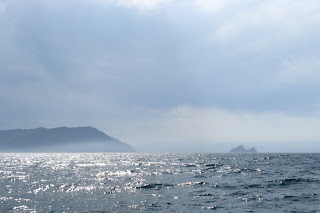 Cook. Brooks Peninsula is a mountainous, rectangular promontory that extends some 6 miles into the ocean. To The First Mate, it looks like an ungainly shoebox jutting out from the land. Positioned at the northwestern point of the Peninsula is Cape Cook, infamous for its conflicting currents and high-velocity winds. We first learned about the Brooks Peninsula last year, after frequently hearing bad weather advisories for the area in the daily marine weather forecasts.
Cook. Brooks Peninsula is a mountainous, rectangular promontory that extends some 6 miles into the ocean. To The First Mate, it looks like an ungainly shoebox jutting out from the land. Positioned at the northwestern point of the Peninsula is Cape Cook, infamous for its conflicting currents and high-velocity winds. We first learned about the Brooks Peninsula last year, after frequently hearing bad weather advisories for the area in the daily marine weather forecasts.Off Cape Cook is Solander Island. Here, the use of the word “island” is a bit over zealous, for the reality is a barren, lifeless mass of rock with shoals and reefs extending out all around it and back to Cape Cook. The guides say to stay at least 1.5 to 2 miles off the coast. We do not intend to test the guides.
Happily for The First Mate, this challenge is still a day away. Today, Sunday, June 29th, is a positioning day. We are only going a few hours south to anchor closer to the take-off point for rounding the peninsula. We leave our anchorage in Winter Harbor after a disappointing surprise from the crab trap. We caught 4 baby flounders – only useful as possible bait. We pick up the shrimp trap in the bay with
 its bounty of one baby shrimp and one baby crab. A very unpromising way to begin the day, but as the wind is up enough to raise sail, we do so and enjoy a few hours of sailing down Brooks Bay. This leg proves to be quite easy, and that is fortunate, because The First Mate cannot seem to keep her eyes open. She feels absolutely drugged which undoubtedly is due to her downer/upper combination of anti-seasickness meds. Bonnie and No Doz. The combined action of sleep-inducing Bonine and the soporific affect of fresh air and lulling sea waves are not being countered by enough eye-opening No Doz. As funny as The Captain seems to think this is, the serious side to all this is that the drugged-up First Mate is all but useless. Something has to be done. The drugs are right; the doses are wrong. More No Doz is called for the next time this regimen is followed.
its bounty of one baby shrimp and one baby crab. A very unpromising way to begin the day, but as the wind is up enough to raise sail, we do so and enjoy a few hours of sailing down Brooks Bay. This leg proves to be quite easy, and that is fortunate, because The First Mate cannot seem to keep her eyes open. She feels absolutely drugged which undoubtedly is due to her downer/upper combination of anti-seasickness meds. Bonnie and No Doz. The combined action of sleep-inducing Bonine and the soporific affect of fresh air and lulling sea waves are not being countered by enough eye-opening No Doz. As funny as The Captain seems to think this is, the serious side to all this is that the drugged-up First Mate is all but useless. Something has to be done. The drugs are right; the doses are wrong. More No Doz is called for the next time this regimen is followed.With the calm sailing conditions, we try fishing. That, too, proves most unsuccessful. We are disappointed because we had truly expected to catch salmon out here on the ocean side of Vancouver. No luck. It appears that the salmon have not yet started to run. How does one start that race?
Outside the entrance to Klaskish Inlet, we drop the shrimp trap optimistically baited with one of those baby flounders. We enter the Inlet and by pass the first anchorage, for our destination is deep inside the Inlet. We slowly motor in looking for a narrow gorge with steep sided walls and overhanging vegetation that is supposed to lead us into Klaskish Basin, a primeval spot of unsurpassed beauty. We think we spot it, but from our angle, it looks more like the outlet to a stream. We continue, questioning, and slowly confirm that th
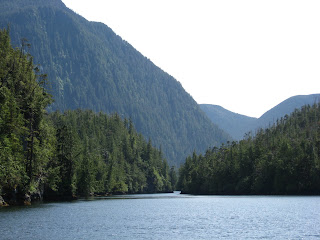 is is indeed our narrow gorge. Though it is a relatively short passage, we cannot see thru to the end. The rock walls are indeed steep. Tree limbs extend out from the walls and bow downward toward the water. Definitely one will not want to or be able to wander far off the centerline. Depth is sufficient for us, as the steep walls generally continue below the water. We are alone down here and do not expect to encounter another boat coming out the passage as we go in, but one never knows. Slowly, we ease our way in.
is is indeed our narrow gorge. Though it is a relatively short passage, we cannot see thru to the end. The rock walls are indeed steep. Tree limbs extend out from the walls and bow downward toward the water. Definitely one will not want to or be able to wander far off the centerline. Depth is sufficient for us, as the steep walls generally continue below the water. We are alone down here and do not expect to encounter another boat coming out the passage as we go in, but one never knows. Slowly, we ease our way in. 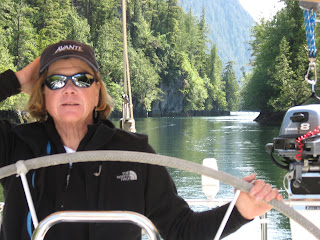
The outside world is quickly closed off as we wind our way deeper in and thru this channel. We emerge into a large hidden basin rimmed with old growth forest. There is an “other world” feel to the place. The solitude encloses you, and the quietness of nature is complete.
There are four large mooring buoys available, and we decide to use one. Our usual practice is to pass on the opportunity to tie up to buoys. With Avante’s size and weight, we can never be sure that the buoys will hold, but these are very large buoys and look reasonably well maintained. It turns out that these buoys are very secure, as they were put here for use by any fishing boat or other vessel that might be caught on the west coast during a bad storm.
The First Mate rounds up into the negligible wind, and as she slowly advances on the buoy, The Captain makes ready to snag it with the boat hook. The buoy disappears below the below the curve of the bow as Avante nears. The Captain climbs over the rails leaning out to grab the top of buoy ring and run our rope thru it. The First Mate holds Avante in position by keeping herself and Avante on line with a distant tree. She glances down to see how The Captain is doing. The Captain? What Captain? Where is he? There’s the buoy bobbing several feet off the bow of the boat. What is it doing there? How did it get there? Oh, shit! (It’s another one of those moments.) What did I do? How did the boat move so from its position right on the buoy? Did I have a brain lapse and switch trees without realizing it? Where’s Bill? In the water? Well, at least, he’ll be able to swim to the side of the boat and will not be lost at sea. But, where is he? There’s not a sound. Maybe I whacked him with the bow and killed him. If not, he’s going to kill me. Then one of us is going to be all alone out here. How did I mess this one up? As with all such ruminations, my questions take up a mere nanosecond. Suddenly a hand lurches up to grasp the rail. Then another hand quickly reaches up. What in heaven’s name is happening? How did Bill get there and what is he doing there? The First Mate dashes forward to help The Captain haul himself over the rail and back into the boat where he belongs.
The Story: The buoy, as can be seen f
 rom the picture, is quite a large one. Most buoys have either thick rope or chain attached to them. One grabs the rope and then one works one’s own rope thru the hook on the buoy thus securing one’s boat to the buoy. Our buoy only has a square-shaped handle on top and no rope to grab onto for easier management. It is also a long reach from the bow of Avante down to the handle on the buoy. As Avante approached, the buoy swiveled in the water so that the opening on the handle was pointing away from The Captain, giving him no easy opportunity to thread our rope thru it. From The Captain’s perspective, the broad base with four large tires supporting each corner of the buoy looked secure enough to step onto, run the rope thru the handle and then jump back onto the boat. Being the resourceful man that he is and always ready with Plan B, The Captain jumped off the boat, landed agilely on the base and discovered to his surprise that his base was anything but secure. Instead, it had all the stable characteristics of a wet noodle standing on end. With The Captain fighting to hang on and maintain balance, the buoy bobbled and canted away from the boat. The Captain quickly looped the rope thru the handle then launched himself back to our boat before the buoy turned turtle under his weight. That was the same instant when The First Mate glanced down to see the buoy bobbling off the bow of the boat and The Captain nowhere in sight. Suddenly that hand appeared grasping upward to catch the rail. Slowly, painfully, feeling each of his 62 years, The Captain hauled himself and the rope back on the boat. To The First Mate’s immense relief, she had not had a mental lapse and she had not done anything wrong. However, to her extreme disappointment, she had missed the look of surprise and angst that must have been on The Captain’s face when the buoy collapsed out from under him. He almost got another cold-water dousing without benefit of wet suit this time.
rom the picture, is quite a large one. Most buoys have either thick rope or chain attached to them. One grabs the rope and then one works one’s own rope thru the hook on the buoy thus securing one’s boat to the buoy. Our buoy only has a square-shaped handle on top and no rope to grab onto for easier management. It is also a long reach from the bow of Avante down to the handle on the buoy. As Avante approached, the buoy swiveled in the water so that the opening on the handle was pointing away from The Captain, giving him no easy opportunity to thread our rope thru it. From The Captain’s perspective, the broad base with four large tires supporting each corner of the buoy looked secure enough to step onto, run the rope thru the handle and then jump back onto the boat. Being the resourceful man that he is and always ready with Plan B, The Captain jumped off the boat, landed agilely on the base and discovered to his surprise that his base was anything but secure. Instead, it had all the stable characteristics of a wet noodle standing on end. With The Captain fighting to hang on and maintain balance, the buoy bobbled and canted away from the boat. The Captain quickly looped the rope thru the handle then launched himself back to our boat before the buoy turned turtle under his weight. That was the same instant when The First Mate glanced down to see the buoy bobbling off the bow of the boat and The Captain nowhere in sight. Suddenly that hand appeared grasping upward to catch the rail. Slowly, painfully, feeling each of his 62 years, The Captain hauled himself and the rope back on the boat. To The First Mate’s immense relief, she had not had a mental lapse and she had not done anything wrong. However, to her extreme disappointment, she had missed the look of surprise and angst that must have been on The Captain’s face when the buoy collapsed out from under him. He almost got another cold-water dousing without benefit of wet suit this time.We are tied up. It is mid-afternoon. The First Mate wants to launch The Dingbat, explore and fish. The Captain has other plans. After lunch, he needs to change the water filters on the water maker. Boat maintenance comes first.

Maintenance completed, we head off to explore the end of the basin where a stream empties. Wildlife, as in “bears”, is supposed to abound, but we see none.
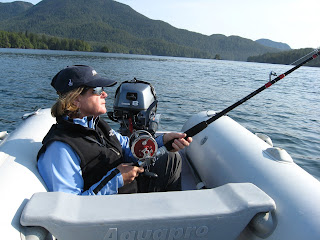
We motor out the narrow gorge into the bay where The First Mate attempts to fish while The Captain reads. It is quiet and peaceful. Though no fish are caught, we do spot several otters floating along on the waves.
As evening approaches, we return to Avante for cocktails and an early dinner. Tomorrow morning we are to engage the infamous Brooks Peninsula.
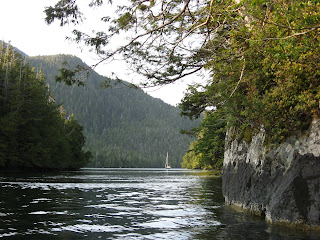 We fall asleep in the quiet of primeval wilderness only to be awoken in the early hours of the morning by what sounds like a freight train barreling down on us. The Williwaws have found us! The Captain explains the phenomena of the land winds blowing down to the sea, then rolls over, and returns to sleep. The First Mate, thoroughly alert now, lays awake listening to the wind screaming its approach before it hits the boat with all its force. How nice that we are so securely tied to this heavy-duty buoy! We are later told that these heavy-duty buoys can be a problem in Williwaws if they get positioned in such a way that one’s boat keeps knocking into them. Friends we later meet experienced this on their night in Klaskish Basin, and the only way to protect their boat was to put out their fenders to cushion the impact and then to stand guard until the Williwaws abated. We were lucky, I deduce, to have missed that exercise.
We fall asleep in the quiet of primeval wilderness only to be awoken in the early hours of the morning by what sounds like a freight train barreling down on us. The Williwaws have found us! The Captain explains the phenomena of the land winds blowing down to the sea, then rolls over, and returns to sleep. The First Mate, thoroughly alert now, lays awake listening to the wind screaming its approach before it hits the boat with all its force. How nice that we are so securely tied to this heavy-duty buoy! We are later told that these heavy-duty buoys can be a problem in Williwaws if they get positioned in such a way that one’s boat keeps knocking into them. Friends we later meet experienced this on their night in Klaskish Basin, and the only way to protect their boat was to put out their fenders to cushion the impact and then to stand guard until the Williwaws abated. We were lucky, I deduce, to have missed that exercise.At 8:00 the next morning, we motor out of the Inlet picking up our empty shrimp trap. Need it be noted that The Captain’s disparaging comments on the lack of success of this shrimp venture are increasing?
The day before, we had checked the weather forecast and learned that conditions were supposed to be favorable around Brooks P
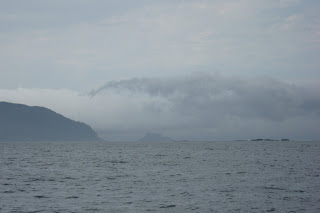 eninsula. However, deep inside Klaskish Basin we had been unable to receive any radio transmission. The first thing The Captain wants to do is get an update on the weather. The sky is overcast, grey and threatening. The First Mate is uneasy with the look of things, but the updated weather forecast shows nothing menacing. The Captain decides to venture forth. Winds are low, but the seas are choppy. Within an hour the winds have picked up to 12 knots so we turn into the wind and raise sail.
eninsula. However, deep inside Klaskish Basin we had been unable to receive any radio transmission. The first thing The Captain wants to do is get an update on the weather. The sky is overcast, grey and threatening. The First Mate is uneasy with the look of things, but the updated weather forecast shows nothing menacing. The Captain decides to venture forth. Winds are low, but the seas are choppy. Within an hour the winds have picked up to 12 knots so we turn into the wind and raise sail. 
Climbing the mast in calm seas and benign winds to attach the main halyard is relatively easy, but it can be an adventure in the boisterous seas that we find in Brooks Bay.
Ever vigilant on the wind monitor, The First Mate sees 20 knots flash and immediately notifies The Captain of this occurrence. Most desirous of a happy crew on this rounding of Brooks Peninsula, The Captain stops to put in the first reef in the mainsail. Much to The First Mate’s chagrin, winds remain variable from 6 to 18 knots, and the 20 knots is not seen again. But that does not diminish her sense of security at having the first reef engaged. Avante is cruising along at 7 to 8 knots even with the single reef. That’s acceptable. Winds move around from NW to SW as we continue out along the northern shore of the Peninsula.
At 11:20, we are abeam Solander Island and Brooks Peninsula, about 3 miles off, and pleased that all is going quite smoothly. South of Solander, we encounter fog. Winds are blowing right on our nose as we tack nicely back and forth down the short side of this ungainly shoebox. Sailing in and out of fog, we round the southwestern point and head back toward the coast. About an hour from our anchorage, the winds decrease to the point where we take down the sails and motor into Columbia Cove to anchor for the evening.

By 4:30, we are anchored and secured. The two most treacherous capes on the west coast of Vancouver Island have been successfully navigated. We are relieved and pleased. Advanced planning coupled with monitoring of wind and weather conditions, as well as a bit of luck, made for uneventful legs. Ahead of us are still 11 days of sailing the waters and exploring the shores of the west coast of Vancouver Island.